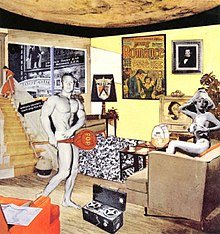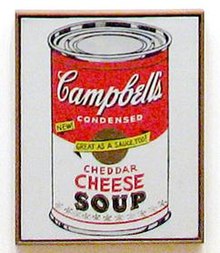United Kingdom: the Independent Group[edit]
Richard Hamilton's collage Just what is it that makes today's homes so different, so appealing? (1956) is one of the earliest works to be considered "pop art".
According to the son of John McHale, the term "pop art" was first coined by his father in 1954 in conversation with Frank Cordell,[11] although other sources credit its origin to British critic Lawrence Alloway.[12][13] (Both versions agree that the term was used in Independent Group discussions by mid-1955.)
"Pop art" as a moniker was then used in discussions by IG members in the Second Session of the IG in 1955, and the specific term "pop art" first appeared in published print in the article "But Today We Collect Ads" by IG members Alison and Peter Smithson in Ark magazine in 1956.[14] However, the term is often credited to British art critic/curator Lawrence Alloway for his 1958 essay titled The Arts and the Mass Media, even though the precise language he uses is "popular mass culture".[15] Nevertheless, Alloway was one of the leading critics to defend the inclusion of the imagery of mass culture in the fine arts.
In London, the annual Royal Society of British Artists (RBA) exhibition of young talent in 1960 first showed American pop influences. In January 1961, the most famous RBA-Young Contemporaries of all put David Hockney, the American R B Kitaj, New Zealander Billy Apple, Allen Jones, Derek Boshier, Joe Tilson, Patrick Caulfield, Peter Phillips and Peter Blake on the map; Apple designed the posters and invitations for both the 1961 and 1962 Young Contemporaries exhibitions.[16] Hockney, Kitaj and Blake went on to win prizes at the John-Moores-Exhibition in Liverpool in the same year. Apple and Hockney traveled together to New York during the Royal College's 1961 summer break, which is when Apple first made contact with Andy Warhol – both later moved to the United States and Apple became involved with the New York pop art scene.[16]
United States[edit]
Roy Lichtenstein is of equal importance to American pop art. His work, and its use of parody, probably defines the basic premise of pop art better than any other.[9] Selecting the old-fashioned comic strip as subject matter, Lichtenstein produces a hard-edged, precise composition that documents while also parodying in a soft manner. Lichtenstein used oil and Magna paint in his best known works, such as Drowning Girl (1963), which was appropriated from the lead story in DC Comics' Secret Hearts #83. (Drowning Girl is part of the collection of the Museum of Modern Art.)[21] His work features thick outlines, bold colors and Ben-Day dots to represent certain colors, as if created by photographic reproduction. Lichtenstein said, "[abstract expressionists] put things down on the canvas and responded to what they had done, to the color positions and sizes. My style looks completely different, but the nature of putting down lines pretty much is the same; mine just don't come out looking calligraphic, like Pollock's or Kline's."[22] Pop art merges popular and mass culture with fine art while injecting humor, irony, and recognizable imagery/content into the mix.
The paintings of Lichtenstein, like those of Andy Warhol, Tom Wesselmann and others, share a direct attachment to the commonplace image of American popular culture, but also treat the subject in an impersonal manner clearly illustrating the idealization of mass production.[9] Andy Warhol is probably the most famous figure in pop art. In fact, art critic Arthur Danto once called Warhol "the nearest thing to a philosophical genius the history of art has produced".[17] Warhol attempted to take pop beyond an artistic style to a life style, and his work often displays a lack of human affectation that dispenses with the irony and parody of many of his peers.[23][24]
Early U.S. exhibitions[edit]
Claes Oldenburg, Jim Dine and Tom Wesselmann had their first shows in the Judson Gallery in 1959 and 1960 and later in 1960 through 1964 along with James Rosenquist, George Segal and others at the Green Gallery on 57th Street in Manhattan. In 1960, Martha Jackson showed installations and assemblages, New Media - New Forms featured Hans Arp, Kurt Schwitters, Jasper Johns, Claes Oldenburg, Robert Rauschenberg, Jim Dine and May Wilson. 1961 was the year of Martha Jackson's spring show, Environments, Situations, Spaces.[25][26] Andy Warhol held his first solo exhibition in Los Angeles in July 1962 at Irving Blum's Ferus Gallery, where he showed 32 paintings of Campell's soup cans, one for every flavor. Warhol sold the set of paintings to Blum for $1,000; in 1996, when the Museum of Modern Art acquired it, the set was valued at $15 million.[17]Donald Factor, the son of Max Factor, Jr., and an art collector and co-editor of avant garde literary magazine Nomad, wrote an essay in the magazine's last issue, Nomad/New York. The essay was one of the first on what would become known as pop art, though Factor did not use the term. The essay, "Four Artists", focused on Roy Lichtenstein, James Rosenquist, Jim Dine, and Claes Oldenburg.[27]
In the 1960s, Oldenburg, who became associated with the pop art movement, created many happenings, which were performance art-related productions of that time. The name he gave to his own productions was "Ray Gun Theater". The cast of colleagues in his performances included: artists Lucas Samaras, Tom Wesselman, Carolee Schneemann, Oyvind Fahlstrom and Richard Artschwager; dealer Annina Nosei; art critic Barbara Rose; and screenwriter Rudy Wurlitzer.[28] His first wife, Patty Mucha, who sewed many of his early soft sculptures, was a constant performer in his happenings. This brash, often humorous, approach to art was at great odds with the prevailing sensibility that, by its nature, art dealt with "profound" expressions or ideas. In December 1961, he rented a store on Manhattan's Lower East Side to house The Store, a month-long installation he had first presented at the Martha Jackson Gallery in New York, stocked with sculptures roughly in the form of consumer goods.[28]
Opening in 1962, Willem de Kooning's New York art dealer, the Sidney Janis Gallery, organized the groundbreaking International Exhibition of the New Realists, a survey of new-to-the-scene American, French, Swiss, Italian New Realism, and British pop art. The fifty-four artists shown included Richard Lindner, Wayne Thiebaud, Roy Lichtenstein (and his painting Blam), Andy Warhol, Claes Oldenburg, James Rosenquist, Jim Dine, Robert Indiana, Tom Wesselmann, George Segal, Peter Phillips, Peter Blake (The Love Wall from 1961), Yves Klein, Arman, Daniel Spoerri, Christo and Mimmo Rotella. The show was seen by Europeans Martial Raysse, Niki de Saint-Phalle and Jean Tinguely in New York, who were stunned by the size and look of the American artwork. Also shown were Marisol, Mario Schifano, Enrico Baj and Öyvind Fahlström. Janis lost some of his abstract expressionist artists when Mark Rothko, Robert Motherwell, Adolph Gottlieb and Philip Guston quit the gallery, but gained Dine, Oldenburg, Segal and Wesselmann.[29] At an opening-night soiree thrown by collector Burton Tremaine, Willem de Kooning appeared and was turned away by Tremaine, who ironically owned a number of de Kooning's works. Rosenquist recalled: "at that moment I thought, something in the art world has definitely changed".[17] Turning away a respected abstract artist proved that, as early as 1962, the pop art movement had begun to dominate art culture in New York.
A bit earlier, on the West Coast, Roy Lichtenstein, Jim Dine and Andy Warhol from New York City; Phillip Hefferton and Robert Dowd from Detroit; Edward Ruscha and Joe Goode from Oklahoma City; and Wayne Thiebaud from California were included in the New Painting of Common Objects show. This first pop art museum exhibition in America was curated by Walter Hopps at the Pasadena Art Museum.[30] Pop art was ready to change the art world. New York followed Pasadena in 1963, when the Guggenheim Museum exhibited Six Painters and the Object, curated by Lawrence Alloway. The artists were Jim Dine, Jasper Johns, Roy Lichtenstein, Robert Rauschenberg, James Rosenquist, and Andy Warhol.[31] Another pivotal early exhibition was The American Supermarket organised by the Bianchini Gallery in 1964. The show was presented as a typical small supermarket environment, except that everything in it—the produce, canned goods, meat, posters on the wall, etc.—was created by prominent pop artists of the time, including Apple, Warhol, Lichtenstein, Wesselmann, Oldenburg, and Johns. This project was recreated in 2002 as part of the Tate Gallery's Shopping: A Century of Art and Consumer Culture.[32]
By 1962, pop artists started exhibiting in commercial galleries in New York and Los Angeles; for some, it was their first commercial one-man show. The Ferus Gallery presented Andy Warhol in Los Angeles (and Ed Ruscha in 1963). In New York, the Green Gallery showed Rosenquist, Segal, Oldenburg, and Wesselmann. The Stable Gallery showed R. Indiana and Warhol (in his first New York show). The Leo Castelli Gallery presented Rauschenberg, Johns, and Lichtenstein. Martha Jackson showed Jim Dine and Allen Stone showed Wayne Thiebaud. By 1966, after the Green Gallery and the Ferus Gallery closed, the Leo Castelli Gallery represented Rosenquist, Warhol, Rauschenberg, Johns, Lichtenstein and Ruscha. The Sidney Janis Gallery represented Oldenburg, Segal, Dine, Wesselmann and Marisol, while Allen Stone continued to represent Thiebaud, and Martha Jackson continued representing Robert Indiana.[33]
In 1968, the São Paulo 9 Exhibition – Environment U.S.A.: 1957–1967 featured the "Who's Who" of pop art. Considered as a summation of the classical phase of the American pop art period, the exhibit was curated by William Seitz. The artists were Edward Hopper, James Gill, Robert Indiana, Jasper Johns, Roy Lichtenstein, Claes Oldenburg, Robert Rauschenberg, Andy Warhol and Tom Wesselmann.[34]



